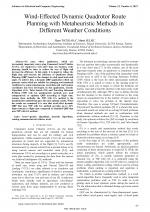| 4/2021 - 8 |
Wind-Effected Dynamic Quadrotor Route Planning with Metaheuristic Methods in Different Weather ConditionsINCEKARA, H. |
| Extra paper information in |
| Click to see author's profile in |
| Download PDF |
Author keywords
genetic algorithms, heuristic algorithms, routing, unmanned aerial vehicles, wind
References keywords
wind(13), unmanned(13), control(13), problem(10), aerial(10), quadrotor(9), vehicle(8), systems(8), routing(8), research(7)
Blue keywords are present in both the references section and the paper title.
About this article
Date of Publication: 2021-11-30
Volume 21, Issue 4, Year 2021, On page(s): 69 - 78
ISSN: 1582-7445, e-ISSN: 1844-7600
Digital Object Identifier: 10.4316/AECE.2021.04008
Web of Science Accession Number: 000725107100008
SCOPUS ID: 85122236431
Abstract
In cases where quadrotors, which are increasingly important rotary-wing Unmanned Aerial Vehicles (UAVs), are required to visit more than one location, route planning should be done to reduce the cost of flight and increase the efficiency. In this study, it is aimed to reduce the flight time and increase the efficiency of Quadrotor Route Planning (QRP) based on the changes in wind speed and wind angle. To achieve this, a dynamic QRP application which can generate routes which are suitable for changing environmental conditions by using instantaneous wind data and real location coordinates has been developed. In this application, Genetic Algorithm (GA), Tabu Search and Traveling Salesman Problem (TSP) with GA metaheuristic methods were used comparatively to optimize QRP according to flight time. Among these methods, the TSP with GA method is the metaheuristic method that gave the most optimal results. When the results are examined, it is seen that wind effect dynamic QRP that uses TSP and GA method provides up to 26% improvements in flight time compared to Standard QRP that uses TSP with GA method. |
| References | | | Cited By |
Web of Science® Times Cited: 2 [View]
View record in Web of Science® [View]
View Related Records® [View]
Updated 3 weeks, 5 days ago
SCOPUS® Times Cited: 2
View record in SCOPUS® [Free preview]
View citations in SCOPUS® [Free preview]
[1] Optimizing multi-drone patrol path planning under uncertain flight duration: A robust model and adaptive large neighborhood search with simulated annealing, Li, Xiaoduo, Luo, He, Wang, Guoqiang, Song, Zhihong, Gou, Qiwen, Meng, Fanhe, Applied Soft Computing, ISSN 1568-4946, Issue , 2025.
Digital Object Identifier: 10.1016/j.asoc.2025.113107 [CrossRef]
[2] Tourism Route Selection Model for Tourism Sustainable Development Based on Improved Genetic Algorithm, Qi, Jingwen, Wang, Qiuhong, Ahmed, Ahmedin M., International Transactions on Electrical Energy Systems, ISSN 2050-7038, Issue , 2022.
Digital Object Identifier: 10.1155/2022/4287011 [CrossRef]
Disclaimer: All information displayed above was retrieved by using remote connections to respective databases. For the best user experience, we update all data by using background processes, and use caches in order to reduce the load on the servers we retrieve the information from. As we have no control on the availability of the database servers and sometimes the Internet connectivity may be affected, we do not guarantee the information is correct or complete. For the most accurate data, please always consult the database sites directly. Some external links require authentication or an institutional subscription.
Web of Science® is a registered trademark of Clarivate Analytics, Scopus® is a registered trademark of Elsevier B.V., other product names, company names, brand names, trademarks and logos are the property of their respective owners.
Faculty of Electrical Engineering and Computer Science
Stefan cel Mare University of Suceava, Romania
All rights reserved: Advances in Electrical and Computer Engineering is a registered trademark of the Stefan cel Mare University of Suceava. No part of this publication may be reproduced, stored in a retrieval system, photocopied, recorded or archived, without the written permission from the Editor. When authors submit their papers for publication, they agree that the copyright for their article be transferred to the Faculty of Electrical Engineering and Computer Science, Stefan cel Mare University of Suceava, Romania, if and only if the articles are accepted for publication. The copyright covers the exclusive rights to reproduce and distribute the article, including reprints and translations.
Permission for other use: The copyright owner's consent does not extend to copying for general distribution, for promotion, for creating new works, or for resale. Specific written permission must be obtained from the Editor for such copying. Direct linking to files hosted on this website is strictly prohibited.
Disclaimer: Whilst every effort is made by the publishers and editorial board to see that no inaccurate or misleading data, opinions or statements appear in this journal, they wish to make it clear that all information and opinions formulated in the articles, as well as linguistic accuracy, are the sole responsibility of the author.



